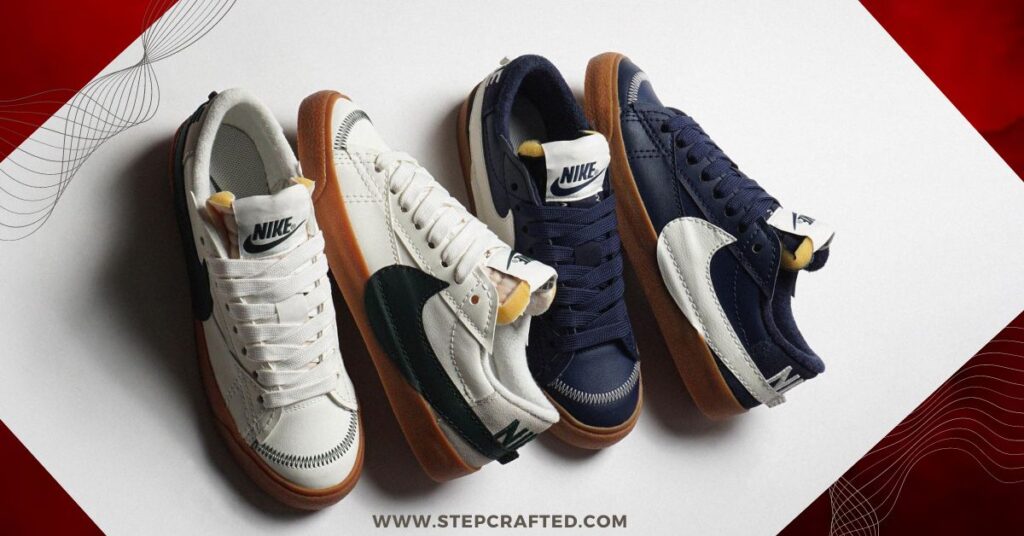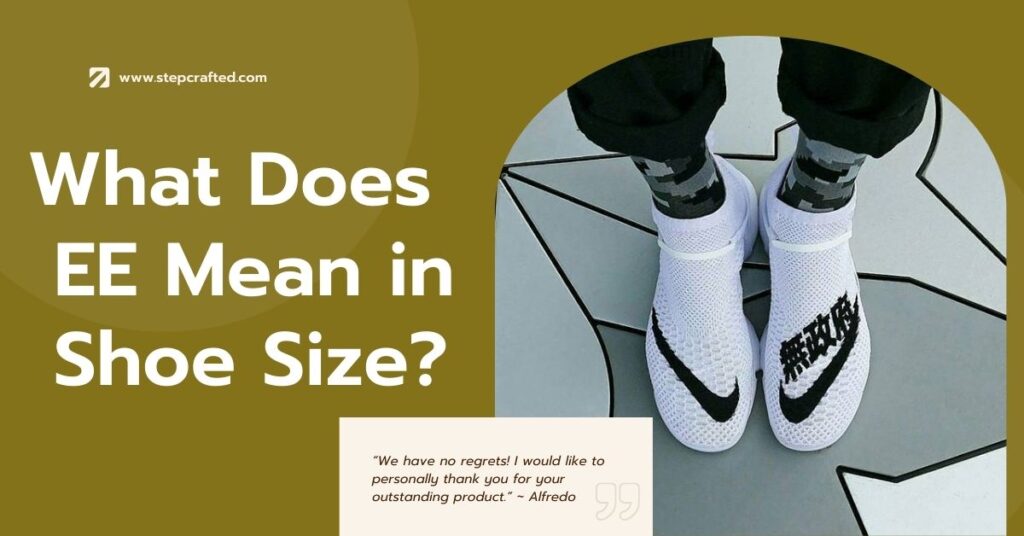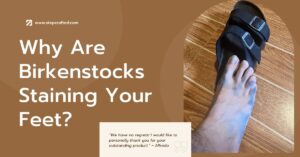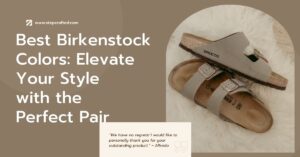In my years of shoe shopping, I’ve come to realize that most people primarily focus on length while often overlooking a crucial aspect that significantly affects their comfort and fit: width.
Contents
ToggleAs someone who has felt the discomfort of a snug fit due to width mismatches, I can’t stress enough the importance of understanding shoe width sizes for example what does EE mean in shoe size.
Letters like E, EE, and DD play a significant role in ensuring your shoes provide not just a tailored fit for the wearer but also overall comfort, positively impacting your posture and gait.
The Basics of Shoe Width
Let me delve a bit into The Basics of Shoe Width, sharing insights that might change the way you look at shoe sizes the next time you go shopping.
In the United States, shoe sizes are measured in both length and width, offering a more tailored fit that accommodates the width of your foot. While the length is usually the number you’re most familiar with, the width is represented by letters. These letters range from the narrowest to the widest, providing nine standard width sizes.
When it comes to width, the letters start from AAA (3A), the narrowest shoe width size, and go up to EEE (3E), the widest shoe width size.
This range is crucial for finding a shoe that not only fits in length but also accommodates the unique width of your foot, thus ensuring optimal comfort and support.
The nine standard shoe width sizes in the U.S. are as follows:
- AAA (3A): Narrowest shoe width size.
- AA (2A): Narrower than 3A.
- A: Narrow shoe width size.
- B: Medium shoe width size for women.
- C: Average shoe width size.
- D: Medium shoe width size for men.
- E: Wide shoe width size.
- EE (2E): Wider than E.
- EEE (3E): Widest shoe width size.
This detailed understanding of width sizes is crucial for anyone buying shoes, especially if you’re looking for that perfect fit that ensures both comfort and support, without compromising on overall well-being. From my experience, paying attention to these details has made a significant difference in how I buy and wear shoes, impacting my comfort and posture positively.
Different Shoe Width Explained
When it comes to shoe shopping, understanding shoe width is as crucial as knowing your shoe length. Many of us have faced the dilemma of a snug fit or a roomy space in our shoes, not because of the length, but due to the width. This is where knowing what EE in shoe size means becomes vital for comfort and foot health.

‘AAA’ in Shoe Width
Starting with AAA or 3A, the narrowest shoe width size available, it’s designed for individuals with extremely narrow feet, offering a snug fit that standard widths can’t provide. Specialised sizes like AAA are not commonly stocked in stores, making finding this width a challenge.
Brands like Salvatore Ferragamo and Stuart Weitzman do offer options in 3A width, but understanding and knowing your shoe width is crucial for comfort and foot health.
‘AA’ in Shoe Width
Moving to AA or 2A, this shoe width is narrower than standard but not as narrow as AAA. It serves as a middle ground for those who find standard widths too roomy but don’t require the extreme narrowness of a 3A. Brands like New Balance, Nike, and Brooks often offer shoes in AA width, making it easier to find compared to 3A.
If you fall into the AA category, you’ll find a better fit and more comfort in shoes designed for your specific needs.
‘A’ in Shoe Width
The ‘A’ width in shoes is categorised as narrow, more common than the extremely narrow options like AA or AAA. This width is suitable for those who find standard widths a bit too spacious but don’t need the snug fit of AA or AAA widths.
Brands such as Clarks, ASICS, and Skechers often have options in ‘A’ width, making it easier to find than its narrower counterparts.
‘B’ in Shoe Width
In the realm of shoe sizes, ‘B’ width is considered the medium or standard width for women, designed for those with average-width feet, offering a balanced fit that’s neither too tight nor too loose.
Knowing that you fit into the ‘B’ width category simplifies your shopping experience, allowing you to focus on style and function rather than fit concerns.
‘C’ in Shoe Width
Lastly, the ‘C’ width in shoes is considered an average or medium width, falling between narrow and wide sizes. It’s a versatile option suitable for those who find narrow widths too constricting but don’t need the extra room provided by wider sizes.
While not as ubiquitous as standard medium widths like ‘B’ for women or ‘D’ for men, ‘C’ width is still relatively common and can be found in many stores and online shops. Understanding your need for a ‘C’ width can greatly enhance your comfort and overall experience when purchasing shoes.
Each of these widths plays a significant role in ensuring a comfortable, supportive fit that accommodates the width of your foot. Whether you’re exploring the narrowest options like AAA or the more common A, B, and C widths, knowing your shoe width is essential.
This knowledge not only improves your shoe shopping experience but also has a positive impact on your comfort, posture, and gait.
‘D’ in Shoe Width
Navigating the world of shoe shopping can be a complex journey, especially when you delve into the nuances of shoe width. While many focus on the length of the shoe, width is a crucial factor that often gets overlooked.
However, understanding the meaning behind width sizes, such as EE, is key to finding that perfect fit that offers both comfort and functionality.
When we talk about D width in men’s footwear, we’re referring to the standard or medium width. This width is designed to accommodate the average male foot, ensuring a fit that’s neither too tight nor too loose
. It’s the status quo of shoe width for men, with D width shoes being virtually everywhere, from physical stores to online. Knowing that you’re a D width can significantly streamline your shoe shopping experience, allowing you to focus on other factors like style and comfort.
‘E’ in Shoe Width
Moving up the width chart, E width shoes are categorised as wide, providing extra room across the ball of the foot and the toe box. This width is ideal for those who find standard or medium widths too restrictive, especially in the forefoot area.
Though not as commonly found as D width for men or B width for women, E width is relatively accessible, particularly in stores that focus on comfort or orthopaedic footwear. Knowing your shoe width as E can be a game-changer in your quest for comfortable, well-fitting shoes.
‘EE’ in Shoe Width
The next step up is EE or 2E width, offering even more width for those who need it. EE width is particularly suited for individuals with significantly wide feet who find that even E width shoes are too snug.
While EE width is not as commonly stocked as standard or medium widths, it is relatively accessible in specialty stores or online shops that focus on wide-fit or orthopaedic footwear. Understanding that you require an EE width is crucial for achieving optimal comfort and foot health, especially for those with notably wide feet.
‘EEE’ in Shoe Width
Lastly, EEE or 3E represents the widest shoe width size available, tailored for individuals with exceptionally wide feet, providing ample room across all areas of the foot. However, finding this width can be a challenge; it’s not commonly stocked in most mainstream stores.
Your best bet is to look in specialty stores or online shops that focus on wide and extra-wide footwear. Knowing that you require a 3E width is vital for both comfort and foot health, particularly if you have exceptionally wide feet.
Through this journey from D to EEE width, it becomes clear that the width of your shoe is just as important as the length. Each width size, from the standard D to the wide EEE, plays a pivotal role in ensuring your feet are not just well-fitted but also comfortable and healthy.
Understanding and knowing your shoe width category can transform your shopping experience, streamlining the process and ensuring you focus on what truly matters – finding shoes that fit well and feel great.
Gender Differences in D-Width Shoes
The world of shoe sizes reveals a fascinating aspect often overlooked: the width of a shoe and how it differs across genders. D width in shoes, for instance, showcases a notable difference in fit between men and women. For men, a D width is considered the standard or medium width, perfectly aligning with the average male foot.
On the flip side, for women, the same D width is considered wide, offering a broader fit than what is typically standard for female footwear.
This discrepancy underscores the importance of understanding gender-specific sizing when shopping for shoes. It’s a clear indication that one size doesn’t fit all, and that gender plays a significant role in determining the right fit.
For anyone venturing into the world of shoe shopping, especially for widths like EE, recognizing these differences can be crucial. It ensures that you find shoes that not only match your length requirements but also provide a comfortable and appropriate fit across the width, tailored to your gender-specific needs.
Brand Variability
When navigating the complex world of shoe sizes and trying to understand what EE means, Brand Variability plays a pivotal role. Not all shoe brands offer a comprehensive range of width sizes.
For instance, New Balance, Clarks, and ASICS are known to provide a variety of widths, catering to a wide spectrum of foot shapes and sizes. This inclusivity allows for a better chance of finding the perfect fit, especially for those needing wider sizes like EE.
However, others may offer only standard or medium widths, presenting a limitation for individuals with unique sizing needs.
This disparity underscores the need to explore different brands when searching for shoes that fit well, particularly if you require sizes outside the standard or medium range. The journey to finding the perfect fit involves recognizing that brand variability in width offerings can significantly impact your options.
Venturing beyond your go-to brands and exploring others could unveil new possibilities and ensure that your feet aren’t just accommodated but comfortably snug in shoes tailored to your specific width requirements.

Additional Tips for Measuring Shoe Width
- Best Practices: It is advisable to get your feet professionally measured. Aim for the afternoon when your feet are at their largest due to natural swelling throughout the day. This ensures a more accurate measurement for both length and width.
- Try Different Styles and Brands: Sizing can vary significantly between brands and even among styles within the same brand. It’s crucial to try on multiple options to secure the best fit. This approach allows you to understand how different brands and styles may affect the width and overall fit of the shoe.
- Understanding shoe width is more than just a sizing detail; it’s a critical factor in ensuring overall foot health and comfort. Whether you are a man or a woman, knowing your shoe width can significantly impact how your shoes fit and feel. Next time you’re shoe shopping, remember to consider not just the length, but also pay attention to the width. This comprehensive approach will help you find shoes that provide comfort, support, and a perfect fit, particularly when you’re trying to decipher what EE means in shoe size.
FAQ
Why Do My Shoes Not Fit?
Discovering that a new pair of shoes doesn’t fit can be puzzling and frustrating. Often, we overlook the fact that shoe widths in the UK vary significantly across men, women, and children. Additionally, the style of footwear plays a crucial role in this conundrum.
Fittings that may apply to one style might not apply to another, leading to an inconsistent fit across different types of shoes. This variability necessitates a deeper understanding of how shoe sizes work, especially when exploring widths like EE.
Moreover, the shape of your feet can greatly impact how well your shoes fit. Those with broad feet often require a wide fit shoe to accommodate the extra width, whereas individuals with a high arch might need flexible fastenings to wear their shoes comfortably.
This highlights the importance of not just knowing your shoe size, but also understanding the shape and structure of your feet. Paying attention to these details can significantly improve your shoe shopping experience, ensuring you select shoes that fit well and provide the comfort and support your feet need.
Why Do My Shoes Come in Different Widths?
Understanding shoe sizes and widths can often feel like a puzzle, especially when we dive into what EE means in shoe size. One fundamental truth stands out: no two people have the same foot shape and size, necessitating varying widths to accommodate a larger variety of individuals.
This diversity in widths ensures that more people can comfortably wear a certain style of shoe, regardless of the uniqueness of their feet. It’s this principle that underlies the different shoe widths you’ll encounter, from standard to wide fit, each designed to match a specific foot shape.
This variety in widths isn’t just about ensuring a snug fit; it also influences the tread on the soles of the shoes and, by extension, the shoes’ overall fit and comfort.
For instance, shoes with a wide fit have a sole with a greater width and a deeper toe box than those with a standard fit. This adaptation means that as the width changes, so too does the shoe’s design and functionality, ensuring that each pair of shoes not only fits but also supports the foot properly, regardless of one’s size or shape.
Does Shoe Width Matter?
Choosing the right shoes width is indeed key to maintaining foot health. Often, we underestimate the impact of shoe width on our feet, focusing primarily on shoe length. However, shoes that are too narrow can significantly harm your feet, causing sores, cramps, and bunions.
These shoes are also likely to be too tight, increasing the chance of sweating and, consequently, the risk of bacterial infection. On the flip side, shoes that are too wide fail to secure your foot properly, causing friction while walking. This can potentially lead to sores and blisters, undermining your ability to walk properly.
Moreover, a well-fitted shoe is not just about avoiding discomfort; it’s about ensuring your toes are gripped correctly. If they’re not, it can lead to further issues, such as hammer toe and nail problems.
The emphasis on shoe width is particularly crucial when considering shoes with widths like EE. Understanding the breadth of shoe widths available and how they correlate with your foot’s shape and size is essential. This ensures not just a comfortable fit but also long-term health and well-being for your feet, making the effort to find the right width well worth it.
How Can I Measure My Shoe Width? (Steps)
Finding the right width for your shoes is crucial, especially when looking into sizes like EE. Here’s how you can measure your feet to ensure you find a pair that fits perfectly:
- Wrap a tape measure around the widest part of your bare foot. This is usually across the ball of your foot, where your toes meet the rest of your foot.
- Place your foot on the ground as if you were standing normally. This ensures that your foot is flattened and spread as it would be in a shoe, providing a more accurate measurement.
- Mark the width of your foot in millimetres on the tape measure. It’s important to measure both feet as one can be slightly larger than the other.
- Use this measurement to determine the shoe width you need. Most shoe brands and stores have a size chart which can help translate your foot’s width in millimetres to the shoe width designation used in their sizing system.
By following these steps, you can better understand what shoe width matches your feet, making it easier to select shoes that provide both comfort and support. Whether you’re considering wide or standard widths, knowing your exact measurements will guide you in your quest for the perfect fit.
Does Shoe Width Increase with Shoe Size?
In exploring shoe sizes and their corresponding widths, a general rule of thumb is that a bigger foot tends to be wider. This isn’t solely about the distance between the widest part of the shoe but also its depth.
When we say shoe size and shoe width are proportional in standard sizing, it’s to acknowledge that as shoes get larger, they may also run wider than what might be necessary for someone with long, narrow feet.
However, it’s important to advise against opting for a larger shoe size with the sole purpose of achieving a wider fit. This approach can inadvertently cause a trip hazard, as the extra length can interfere with natural walking patterns.
Understanding that shoe width should be applied carefully and considering both the distance and depth of a shoe can help in selecting a size that not only fits in length but also matches the width of your foot, ensuring safety and comfort in every step.
Should I Pick Shoe Width D or EE if My Shoe Width is E?
Navigating through the maze of shoe sizes and widths can be quite the challenge, especially when considering the nuanced differences between D, E, and EE widths. In the realm of shoe sizing, D is typically considered wide for women and Medium for men, while E is seen as extra wide for women and EE stands as wide for men.
This categorization itself showcases the subjective nature of shoe widths across different demographics. Drawing from personal experience and insights gained as a former menswear shoe salesman and military personnel, the reliability of scanners for measuring shoe size has often been put into question.
Instances at boot camp and visits to Road Runner Sports have taught me that machines can sometimes misjudge sizes, recommending a 13EE when a 10E for boots and 11D for sneakers would suffice.
This emphasizes the importance of verifying your shoe size and width with a traditional Brannock device, a trusted method that has stood the test of time. To directly address the query of whether to opt for D or EE when your shoe width measures as E, the consensus leans towards EE.
Considering E is a legitimate size but seldom manufactured due to brands typically choosing “average” sizes, EE offers that little extra room that could be the difference between comfort and discomfort. This advice, however, is brand and model dependent, as some shoes may inherently tend to be narrower or wider.
Furthermore, for those with E width feet, an alternative strategy involves buying D width shoes and applying loose lacing techniques—lacing every other eyelet to make the shoe roomier. This can be a workaround for those unable to find their exact width in the market.
Ultimately, the decision depends on personal comfort, the specific brand, and model of the shoe, underlining that sometimes, a little extra room is indeed better than not having enough.





